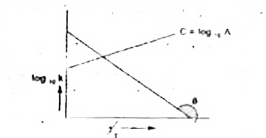The rate constant of a reaction increases by 5% when its temperature is raised from 27∘c to 28∘c. The activation energy of the reaction is
36.6kJ/mol
16.6kJ/mol
46.6kJ/mol
26.6kJ/mol
The correct Answer is:A
To find the activation energy (EA) of the reaction given that the rate constant increases by 5% when the temperature is raised from 27°C to 28°C, we can use the Arrhenius equation in the form of the logarithmic relationship between the rate constants and temperatures.
1. Identify Given Values:
- Initial temperature (T1) = 27°C = 27 + 273 = 300 K
- Final temperature (T2) = 28°C = 28 + 273 = 301 K
- Rate constant at T1 (K1) = 100 (assuming an arbitrary value for simplicity)
- Rate constant at T2 (K2) = K1 + 5% of K1 = 100 + 5 = 105
2. Use the Arrhenius Equation:
The relationship between the rate constants and temperatures can be expressed as:
logK2K1=EA2.303R⋅(T2−T1)T1⋅T2
3. Substitute Known Values:
- K2=105
- K1=100
- R=8.314J/mol K
- T1=300K
- T2=301K
Substitute these values into the equation:
log105100=EA2.303⋅8.314⋅(301−300)300⋅301
4. Calculate the Logarithm:
log105100=log1.05≈0.02119
5. Calculate the Temperature Difference and Product:
T2−T1=301−300=1K
T1⋅T2=300⋅301=90300K2
6. Substitute Values into the Equation:
0.02119=EA2.303⋅8.314⋅190300
7. Rearranging to Solve for EA:
EA=0.02119⋅2.303⋅8.314⋅90300
8. Calculate EA:
- First calculate 2.303⋅8.314≈19.1
- Then calculate 0.02119⋅19.1≈0.404
- Finally, EA≈0.404⋅90300≈36465.2J/mol≈36.5kJ/mol
9. Final Result:
The activation energy (EA) of the reaction is approximately 36.65 kJ/mol.
- Initial temperature (T1) = 27°C = 27 + 273 = 300 K
- Final temperature (T2) = 28°C = 28 + 273 = 301 K
- Rate constant at T1 (K1) = 100 (assuming an arbitrary value for simplicity)
- Rate constant at T2 (K2) = K1 + 5% of K1 = 100 + 5 = 105
The relationship between the rate constants and temperatures can be expressed as:
logK2K1=EA2.303R⋅(T2−T1)T1⋅T2
- K2=105
- K1=100
- R=8.314J/mol K
- T1=300K
- T2=301K
log105100=EA2.303⋅8.314⋅(301−300)300⋅301
log105100=log1.05≈0.02119
T2−T1=301−300=1K
T1⋅T2=300⋅301=90300K2
0.02119=EA2.303⋅8.314⋅190300
EA=0.02119⋅2.303⋅8.314⋅90300
- First calculate 2.303⋅8.314≈19.1
- Then calculate 0.02119⋅19.1≈0.404
- Finally, EA≈0.404⋅90300≈36465.2J/mol≈36.5kJ/mol
The activation energy (EA) of the reaction is approximately 36.65 kJ/mol.
Topper's Solved these Questions
- CHEMICAL KINETICS BOOK - MHTCET PREVIOUS YEAR PAPERS AND PRACTICE PAPERSCHAPTER - CHEMICAL KINETICS EXERCISE - MHT CET CORNER
20 Videos
- CHEMICAL KINETICS BOOK - MHTCET PREVIOUS YEAR PAPERS AND PRACTICE PAPERSCHAPTER - CHEMICAL KINETICS EXERCISE - Exercise 1
63 Videos
- BIOMOLECULES BOOK - MHTCET PREVIOUS YEAR PAPERS AND PRACTICE PAPERSCHAPTER - BIOMOLECULES EXERCISE - MHT CET CORNER
24 Videos
- CHEMICAL THERMODYNAMICS AND ENERGETICBOOK - MHTCET PREVIOUS YEAR PAPERS AND PRACTICE PAPERSCHAPTER - CHEMICAL THERMODYNAMICS AND ENERGETICEXERCISE - MHT CET Corner
40 Videos
Similar Questions
The specific rate constant of a particular reaction quadruples when temperature is changed from 27∘ to 47∘C. Find activation energy for the reaction.
View SolutionThe rate constant of a reaction increases by five times on increase in temperature from 27∘C to 52∘C . The value of activation energy in kJmol−1 is ______ (Rounded-off to the nearest integer)
View Solution
Knowledge Check
When the temperature is increased, heat is supplied which increases the kinetic energy of the reacting molecules. This shall increase the number of collisions and ultimately the rate of reaction shall be enhanced. Arrhenius suggested a equation which describes K as a function of temperature, i.e.
k=Ae−Ea/RT
where
k= rate constant
A= a constant (frequency factor)
Ea= energy of activation
log10k=log10A−Ea2.303R[1R]
Y=C+MX
It is the equation of straight line with negative slope. On plotting log10k against [1T] we get a straight line as shown below :

The slope gives activation energy and intercept gives frequency factor.
Also log.k2k1=Ea2.303[T2−T1T1T2]
The rate constant of a reaction is increased by 5% when its temperature is raised from 27∘C to 28∘C . The activation energy of the reaction in kJ/mol isA36.6B16.6C46.6D26.6The rate of a reaction becomes 4 times when temperature is raised from 293 K to 313 K. The activation energy for such reaction would be
A50.855 kJ mol−1B52.849 kJ mol−1C54.855 kJ mol−1D56.855 kJ mol−1A particular reaction rate increases by a a factor of five when the temperature is increased from 5∘ to 27∘ C. What is the activation energy of the reaction?
A6.10 KJ .mol−1B18.9 KJ .mol−1C50.7 KJ .mol−1D157 KJ .mol−1
If the rate of a reaction gets doubled as the temperature is increased from 27∘ to 37∘C. Find the activation energy of reaction?
View SolutionThe rates of most reactions double when their temperature is raised from 298 K to 308 K. Calculate their activation energy.
View SolutionThe rate constant of a reaction increases by 7% when its temperature is raised from 300 K to 310 K, while its equilibrium constant increases by 3%. Calculate the activation energy of the forward and reverse reactions.
View SolutionThe specific rate constant for a reaction increases by a factor of 4, if the temperature is changed from 27∘C to 47∘C. Find the activation energy for the reaction.
View SolutionThe rates of most reactions double when their temperature is raised from 298 K to 308 K. Calculate their activation energy.
View Solution